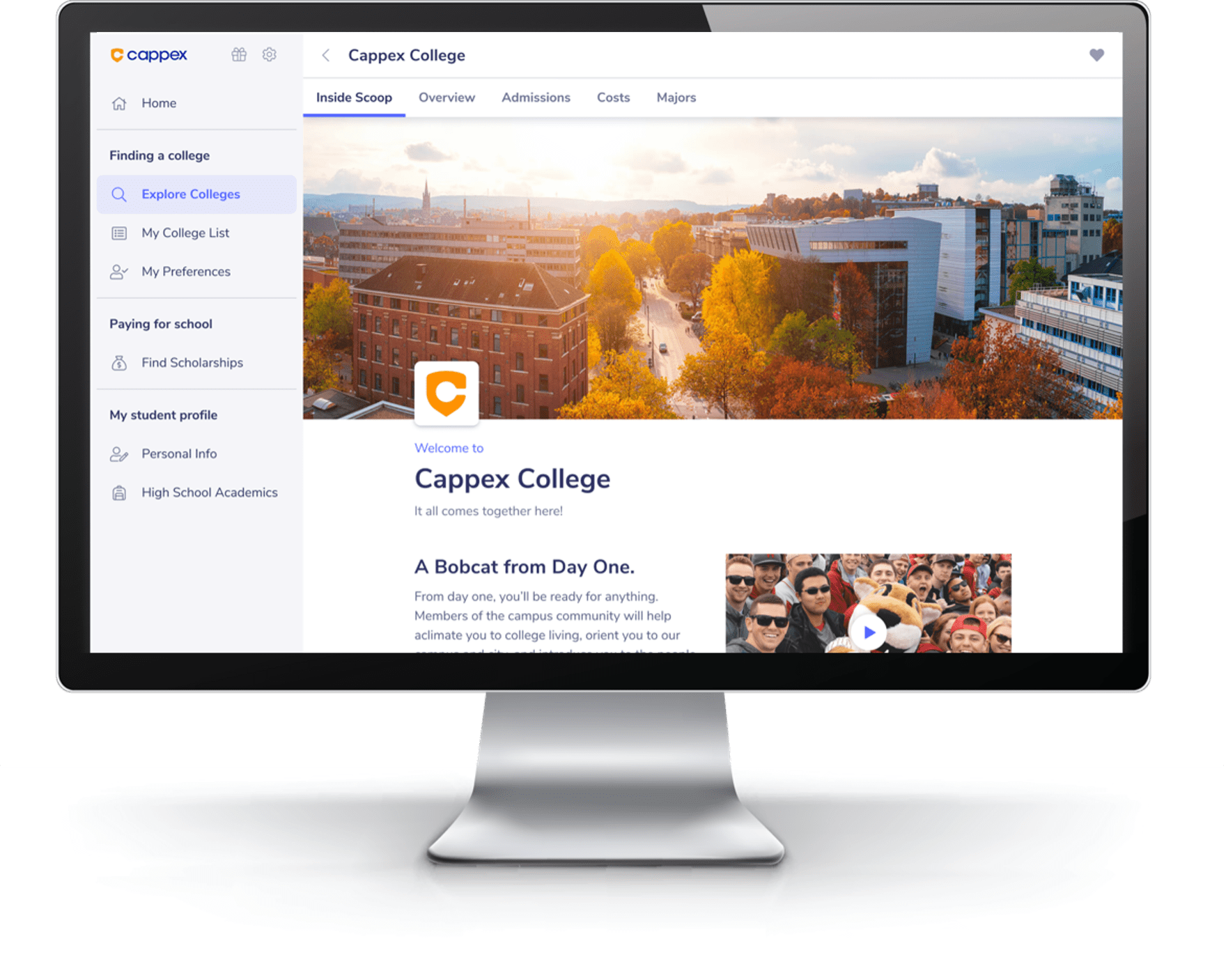4 Digital Marketing Channels to Harness for Student Recruitment in 2023
When it comes to recruiting Gen Z and optimizing student lead generation, the question isn’t the degree to which you should lean on digital channels; rather, it’s which digital channels you should prioritize at any given time.
Today’s tech-savvy generation has long utilized the internet as a means for researching their college options and they’re using a wide array of channels to do so. But with limited budget and staffing resources, schools must optimize the channels that will be most effective at engaging Gen Z.
In this blog post, I’ll share 4 channels that deserve extra focus in 2023, and how best to ensure your messaging resonates with Gen Z when they engage with you on those channels.
-
60%
of Gen Z students believe that first impressions from digital sources are more important than in-person ones.
-
91%
of students believe that every college should have a social media presence.
1. Your school’s website
While the proliferation of new digital platforms has been largely positive for students in their daily lives, it has created mixed results for institutions. For one, it creates more competition for student attention. Furthermore, when external sources (like college-ranking websites or social media influencers) share information about your school, they may be sharing messages that are counter to your brand narrative.
- 51% of students consider your website to be a top source of information.
This is why your institution’s website is so important. There is no college search tool that students prefer more-but in order to serve them best, you need to account for three important priorities: search-engine optimization, a flawless user experience, and highly engaging content.
Here’s an overview of what you need to know for each website priority-and you can read my colleague’s recent blog post for more detail.
Website Priorities
Search-engine optimization (SEO)
- Most students make their way to your website via search engines. Where and how often your school appears in search results is determined by algorithms that rank your site using a complex and ever-evolving set of criteria—keywords used in your content, for example, or the extent to which sites outside of your .edu domain link back to your content.
- Criteria used by algorithms also include less obvious technical features of your site, such as load speed and site architecture. SEO combines a deep understanding of these algorithms with clear thinking about your school’s recruitment strategy. This helps to identify site modifications that will ensure that your school’s site consistently ranks high in searches performed by prospective students.
Flawless user experience
- User experience (UX) can be difficult to define because it’s so seemingly obvious—is your site easy to use or not?
- But there’s a lot of complex work that goes on behind the scenes to create the sort of engaging, streamlined, and intuitive feel the best websites have. This includes mobile optimization and the many “invisible” technical considerations that help determine a site’s usability—the file formats it uses, for example, which can greatly influence a site’s speed and responsiveness.
- More importantly, a positive user experience depends on effective information architecture and, in turn, on sound content strategy—how information is organized, based on a deep understanding of the needs of your audience.
Highly engaging content
- At the end of the day, it’s the content students find on your website that most profoundly shapes their understanding of you. And how impactful your content is ultimately boiled down to two factors: medium and message.
- Message is clearly important; students are unlikely to engage with your content if you haven’t figured out what matters most to them and ensured your website delivers. But the medium used to convey those messages—text, voice, photography, video, and interactive formats—is just as important.
Digital Production
Advances in digital production techniques mean that it’s now possible to incorporate into your website features such as immersive 360° video with embedded rich media, interactive functionality, and graphic overlays (while not requiring end users to install third-party plug-ins—a traditional downside of advanced formats). This creates a highly engaging user experience; EAB research has shown that interactive features can increase the amount of time students spend on web pages by more than a third.
- 38% increase in the amount of time students spend on web pages by adding interactive content.
Discover How Eab Can Help You Optimize Your Website
2. Social media platforms
With 78% of Gen Z students using social media, it’s clear that these platforms present a prime opportunity to engage with new prospects. But with new channels popping up regularly, it can be difficult to identify which platforms will best support your goals.
A Pew Research Center survey found that YouTube is the most popular platform in use by American teenagers aged 13-17, with 95% of them reporting use of the platform. This is followed by TikTok, which has skyrocketed in popularity in just a few short years to become the second most-used platform among this age group (67% of teens report using it with 16% saying that they use it almost constantly). Instagram and Snapchat round out the top four, both of which are used by roughly 60% of teens.
Noticeably low on the list of platforms are Facebook and Twitter. 23% of teens reported using Twitter while 32% reported using Facebook-a stark difference from the This also underscores that while both millennials and Gen Z are digital natives, they have starkly different preferences when it comes to social media platforms and those differences must be reflected in your Gen Z recruitment strategy.
- 75% of parents say they want to hear directly from colleges, up from 71% in 2020.
Once you’ve identified the platform(s) that you wish to harness, you’ll have to pay careful attention to your content strategy. Remember, Gen Z craves immersive and authentic content. You’ll want to make sure that you offer a window in your school’s academic and extracurricular experiences in a way that is authentic to that platform’s intention. For example, on TikTok, you may get more engagement by having a student ambassador post a “day in the life” video while on Instagram, you could be better served by posting high-quality photos from a recent event on campus.
Finally, it’s important to note that students aren’t the only ones on social media-their parents are too. While platforms like Facebook and Twitter are less effective for engaging with Gen Z, they are a prime way to connect with parents and guardians, who are craving more communication from colleges.
Learn More About How To Optimize Your Recruitment Channels
 3. College search platforms
3. College search platforms
During the pandemic, as students spent more time at home, they had less access to many of the information sources that traditionally informed recruitment decisions, including campus visits, friends and classmates, high school counselors, college fairs, and teachers. As a result, they turned to self-service sources to fill those gaps, including parents and family members, social media, and college search platforms like Cappex.
- 25% of students considered college search sites to be a top source of information-a 108% increase since 2020.
- #1 in 2021, Naviance by PowerSchool® students ranked the platform as their top source of information—ahead of college websites, family members, emails from colleges, and school counselors/teachers.
- 41% of all US high school students are using Naviance.
In 2021, Naviance by PowerSchool® students ranked the platform as their top source of information-ahead of college websites, family members, emails from colleges, and school counselors/teachers.
These platforms not only allow you to engage with students on third-party platforms while retaining control of your brand narrative, but they also allow you to connect with right-fit students who have a self-identified interest in going to college. This is distinct from student leads sourced from test providers.
As of December 2022, 35 states require high school students to take the SAT or ACT in order to graduate-regardless of their postsecondary plans. This reduces the degree to which you can assume that these students are college-bound. But with platforms like Cappex and Intersect (which partners with Naviance), you can engage with students who are more likely to apply and enroll.
Discover How Intersect Can Help You Engage With Naviance Students
4. Virtual tours
In the class of 2022, 75% of students reported attending at least one virtual tour-up from 49% in 2020. With campuses being forced to shut down during the pandemic, students had little choice but to rely on digital options. Even with a strong return to on-campus visits, we expect virtual tours to continue to play a central role in Gen Z’s college search since they cater to students’ desire for self-desired, flexible, and easily accessible sources.
Additionally, virtual tours can also help you connect with lower-income students who may not have the means to travel to campus. Research from our 2022 survey found that students with family incomes of more than $120,000 per year were 83% more likely to have visited more than three schools in person than families making $60,000 or less. With virtual tours, the gap in usage across income groups shrinks to 56%.
But what makes a top-notch virtual tour? We’ve broken this down into five key areas. You can also download our toolkit for more information.
5 Key Areas for Your Top Notch Virtual Tour
Storytelling: Does your virtual tour tell a compelling story?
An exceptional virtual tour tells a relatable and authentic story about your institution and creates an emotional connection with your audience.
Engagement: Does your virtual tour have engaging content?
An exceptional virtual tour combines the right types of content, in the right places, to keep visitors engaged.
User Experience: Does your virtual tour provide an exceptional user experience?
An exceptional virtual tour is user-friendly, intuitive, and easy to navigate.
Accessibility: Is your virtual tour accessible?
An exceptional virtual tour is accessible anywhere and everywhere. It should be available across all devices and provide equal access to all people.
Analytics: Does your virtual tour provide insights?
An exceptional virtual tour not only provides a great experience to visitors but also provides insights about the visitors.
More Blogs

AI visibility is critical when competing for student enrollments

The higher ed SEO checklist

 3. College search platforms
3. College search platforms